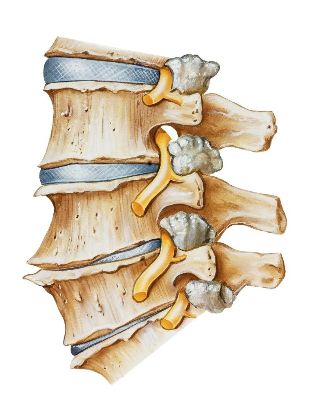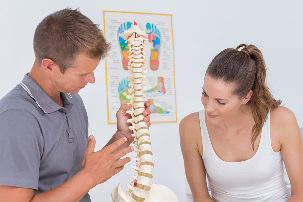Chest-pain – a chronic illness based on degenerative-degenerative changes in intervertebral discs of cartilage lesions, which leads to reactive-side wire and the soft tissue of the vertebrae that surrounds them. The disease itself and widespread human impacts are mainly of working age (25 to 45 years).
Very rare chest pain, more lumbar or cervical. The reason for this is the month of the spine in static and the engine load is less than the other. However, much more difficult to diagnose thoracic osteochondritis, in most cases it flows, imitation, lung diseases, heart, organs, the upper part of the digestive system.

Causes and risk factors
Currently, the exact causes, development, thoracic degenerative disc disease is not installed. A large number of experts suggested by the theory (infectious, allergic, hereditary, mechanical, hormonal, vascular), but none of them were clear, and exact description of the pathological changes occurring in the spine and tissue degeneration of why. Thoracic degenerative disc disease most likely at the same time participates in the development of the pathological mechanism of several different factors. But the core values of the long-static-dynamic vertebral segment extreme.
Factors, why such extreme include:
- abnormalities of the spinal structure;
- the asymmetric intervertebral joint crack joint location;
- congenital spinal canal narrowing;
- Nov spondylogenic (myofascial reflected) and/or somatic (reflected on the background, resulting in a series disease of the blood vessels, and internal organs) pain;
- prolonged exposure, vibration of the spine, for example, motor vehicle drivers;
- physical tension;
- obesity;
- cigarette;
- a sedentary lifestyle (lack of exercise );
- psychosocial factors.
Mobility Spinal intervertebral disc is provided, at the same time and play a cushioning role. Around its center elastic gelatinous core, the composition a large amount of water enters. As a result of an osteochondrosis begins to lose water demineralization core polysaccharides. Over time, the core flattens and flattens and the intervertebral disc it with him. A fibrous ring under the influence of the mechanical load stick out, this process is called the protrusion. Then, pieces of the core falling through the cracks gelatinous disk, i.e., the formation of intervertebral disc herniation.

Violation of convergence causes the two adjacent vertebrae anatomy model disk height reduction joint. Inflammation of the joints and surrounding soft tissue reactance model who started all this. In addition, the convergence and joint capsule and stretching the spine vertebrae of the affected segment was accompanied by the wire become unstable. Hyperactivity vertebral body accomplish this time, a non-violation cause of spinal roots and the development of radicular syndrome.
Tel thoracic vertebral degenerative disc disease slowly growing in the background creates bone tissue, bone protrusions (osteophytes). Compression radicular syndrome or because they can myelopathy (spinal cord compression).
Classification
Thoracic degenerative disc disease lies posindromnoy basic classification principle. Depending on which border education, the structure of the spine affected the impact properties, the following syndromes:
- based on lies in the development of compression, deformation, or multiplication of the nerve root, the plot, spinal cord, brain, or blood vessels, depending on what will develop, vascular or spinal radicular syndromes;
- reflex – reflex innervated by Nov connected voltage, dystrophic and vascular disorders;
- bioadaptive.
Thoracic degenerative disc disease symptoms
The main symptom is thoracic pain and degenerative disc disease. In most cases, it wears that stupid a moderate character.
Long-term irritation of the spinal root causes, disorders of innervation of the internal organs. Depending on the level of the lesion osteochondritis of the chest can flow under the mask of somatic pathologies:
| The level of the lesion | Organs innervated by | Clinical symptoms |
| C7-Th1 | Hand, wrist, palm, trachea, esophagus | Hand and palm pain, bronchial asthma |
| Th2-Th3 | Heart, pericardium, coronary artery | Coronary heart disease, arrhythmia |
| Th4-Th5 Oven | Bronchi, lungs, pleura glands, milk glands and breast | Bronchitis, pneumonia, pleurisy>[!@#$], bronchial asthma |
| Oven Th5-Th6 Advance | The common bile duct, gall bladder | Jelchnokamenna disease, crushing the absorption of fat |
| Th6 Pre-Pre-Th7 | Liver, solar plexus | Liver dysfunction |
| Th7-Th8 | Stomach | Dyspepsia, gastritis, ulcer disease, gastric and duodenal ulcer |
| Th8-Th9 | Duodenum, intestine, pancreas, liver | Digestive disorders and chair, duodenitis, pancreatitis |
| Th9-Th10 | Spleen, diaphragm | Hiccup, respiratory disorder |
| Th10-Th11 | The adrenal glands | Allergic reactions, immune |
| Th11-Th12 | Kidney | Pyelonephritis, kidney stones |
| Th12-L1 | Kidney and ureter | Voiding disorders |
In this context there are the most common symptoms of Thoracic degenerative disc disease:
- chest pain (chest, chest, back, intercostal by the way) – and as sharp as it could be aching, dull; often radiating arm;
- this pain is under – exposed, depending on the nature outside, power, features, diet; often together, heartburn, nausea, vomiting;
- the pain in the right hypochondrium reinforced when changing the position of the patient's body, sneezing, cough;
- pain in the lumbar region – the composition of which is based on imitation of the crisis colic dysuric disorders often come together.

Intercostal neuralgia is a nerve root compression in patients with osteochondrosis of the breast the evolving crisis. For him a characteristic appearance of an acute chest pain, half (torakalgiya). As herpes progresses the pain nerves of the spine is worn and weather spread the intercostal the sternum. Patients described as "electric shock" or "back pain". This area is under continuous murmur region that can give pain, shoulder, arm, and along with some of the other symptoms (local hyperhydrosis, pallor or flushing) with sympathetic fibers intercostal nerve involvement.
For intercostal neuralgia characterized by pain, often times can last from a few seconds to a few minutes between. During a seizure, the pain is almost unbearable. While running, a little alleviate the situation, patients, ice cream, avoiding certain body position, deep breathing, coughing, sneezing, returns.
In patients with marked pain attacks are outside paresthesia (subjective chills crawled as a violation of skin sensitivity, stomach big, tingling, pins) on-the-go intercostal space.
Diagnosis
Diagnostic thoracic degenerative disc disease that is kept based on the data of objective examination, laboratory and instrumental survey contains:
- complete blood count (moderate leucocytosis, increased erythrocyte sedimentation rate);
- serum electrolytes, blood (low calcium levels);
- urinalysis;
- blood chemistry;
- the X-ray study of the thoracic (vertebrae slippage of the wire adjacent the wire flattening deformation of the intervertebral disc subsequent plaque detection the two adjacent vertebrae relative to each other);
- scintigraphy spine (spine wire detection is actively in the process of bone mineralization);
- miyelografi;
- computer and magnetic resonance tomography.
Osteochondritis Chest Diseases and pathological conditions in the differential diagnosis requires the following:
- dishormonal spondylopathy;
- spondylolisthesis;
- inflammatory process;
- ankylosing spondylitis;
- osteomyelitis of the spine;
- rheumatoid arthritis;
- the neoplastic process (primary tumor or metastasis, chest);
- fractures of the spine;
- the disease of the gastrointestinal tract (chronic pancreatitis, ulcer disease, gastric and duodenal ulcer, diverticulitis, syndrome, irritable colon);
- diseases of the urinary system (kidney stones, it's pyelonephritis);
- of the disease of the cardiovascular system (ischemic heart disease, arrhythmia).

Treatment of Thoracic degenerative disc disease
Thoracic degenerative disc disease treatment is done on an outpatient basis. When the patient's pain syndrome prescribe bed rest for 2-3 days. Shows traction of the spine segment from the middle of the affected nerve root compression, and thus can stop pain syndrome. When you migrate pain syndrome soft tissue infiltration 2% novocaine solution. Prescribed a short course of non-steroidal anti-inflammatory drugs.
Thoracic degenerative disc disease comprehensive treatment schema including:
- antihistamines;
- B group vitamins;
- calming;
- acupuncture;
- Ankara;
- manual therapy.
Then the condition of the patient exercise therapy to improve physical therapy for his guidance lessons. Regular physical exercise promote the formation of breast milk during osteochondrosis, a well-developed spine in the correct physiological position corset to keep providing Nov eliminates unwanted static load.
Noteworthy in the treatment of Thoracic degenerative disc disease is called regular moderate physical activity (swimming, yoga, tai-chi), normalization, and body mass index. Jumping, running, weightlifting and other sports accompanied by elevated loads as the spine, is contraindicated in.
Surgical treatment of Thoracic degenerative disc disease is prevalent where only significant cord compression. In such cases, during rush-up, depending on to perform:
- stability of the vertebral segment;
- the affected artificial disc replacement implant;
- renewal Laser disk;
- affected by the evaporation of the puncture disc;
- microdiscectomy.
Possible effects and complications
Long-term irritation of a nerve root, or motor that may trigger the development of somatic diseases, the chest, the upper part of the digestive system, kidneys. Osteochondritis represent the greatest danger to the chest infarction.
In addition, the results of Thoracic degenerative disc disease diseases of the esophagus, stomach, duodenum, pancreas, gall bladder, lung, formation of intervertebral hernia.
Guess
Chest pain that is characterized by an alternating current, which accompany exacerbations of remission. A treatment method is, of course, the recommendations of any doctor related to the patient disease treatment and lifestyle changes, it looks good.
Prevention
Thoracic degenerative disc disease prevention include:
- a body mass index of normalization;
- smoking cessation;
- an active lifestyle.
































